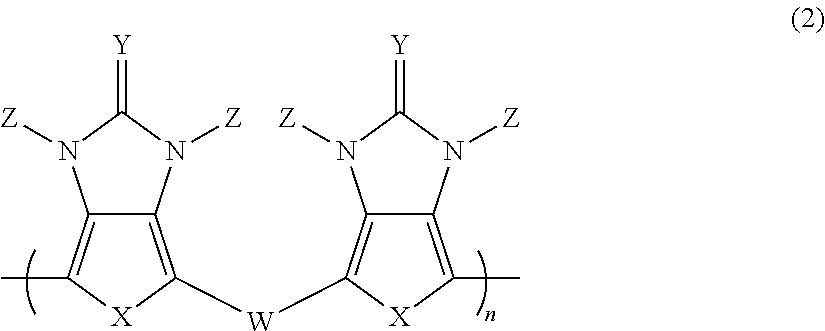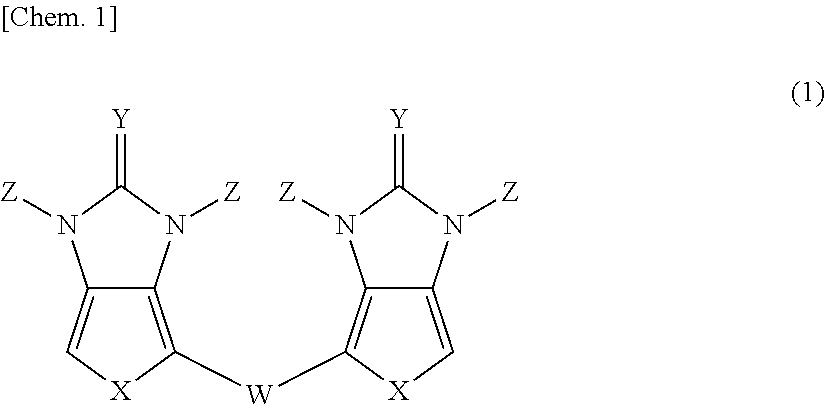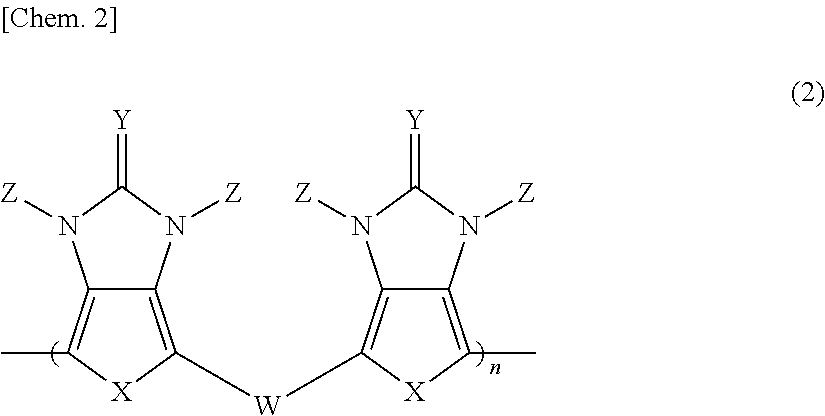Pi-electron conjugated compound, manufacturing method therefor, and pi-electron conjugated polymer obtained using same
a technology of pi-electron and conjugated polymer, which is applied in the direction of group 3/13 element organic compounds, instruments, static indicating devices, etc., can solve the problems of deteriorating viewability, visual fatigue, and the amount of paper consumed daily for books, magazines, newspapers
- Summary
- Abstract
- Description
- Claims
- Application Information
AI Technical Summary
Benefits of technology
Problems solved by technology
Method used
Image
Examples
production example 1
Synthesis of 1H-thieno[3,4-d]imidazol-2(3H)-one represented by formula (3a)
[0129]
[0130]A mixed acid was prepared using 11 ml of fuming nitric acid and 20 ml of fuming sulfuric acid. To a solution prepared by adding 13 ml of concentrated sulfuric acid to that mixed acid was dropped slowly 7.5 g (31 mmol) of 2,5-dibromothiophene represented by formula (15a), and stirring was done for 3 hours while the temperature was kept at 20 to 30° C. with a water bath, and then the reaction was stopped by transferring the liquid in a flask to a container containing 90 g of ice. The resulting solid was collected by filtration and it was recrystallized using methanol, so that 2,5-dibromo-3,4-dinitrothiophene was obtained. The yield based on 2,5-dibromothiophene was 66%. To the resulting 2,5-dibromo-3,4-dinitrothiophene was added 12 N concentrated hydrochloric acid at a rate of 6.05 ml / mmol. While the temperature of the resulting solution was kept at 0° C. with an ice bath, tin in an amount of 7.1 eq...
example 1
Synthesis of 4-[4-(2-oxo-2,3-dihydro-1H-thieno[3,4-d]imidazol-4-yl)phenyl]-1H-thieno[3,4-d]imidazol-2(3H)-one represented by formula (1a) and a polymer represented by formula (2a)
[0139]
[0140]The resulting 1H-thieno[3,4-d]imidazol-2(3H)-one represented by formula (3a) was dissolved in 10 ml / mmol of tetrahydrofuran and was kept at −78° C. in a dry ice-cooled methanol bath. To this was dropped slowly 2.1 equivalents of N-bromosuccinic imide dissolved in tetrahydrofuran of an amount of 5 ml / mmol relative to the 1H-thieno[3,4-d]imidazol-2(3H)-one represented by formula (3a), followed by a reaction for 30 minutes, and then the reaction was stopped by adding an excessive amount of a saturated aqueous sodium chloride solution. The product was extracted from the reaction liquid to an organic layer using diethyl ether and dried over sodium sulfate and then the solvent was evaporated, followed by a purification step by column separation using an ethyl acetate / hexane solvent, so that 4,6-dibrom...
example 2
Synthesis of 4-[9-methyl-6-(2-oxo-2,3-dihydro-1H-thieno[3,4-d]imidazol-4-yl)-9H-carbazol-3-yl]-1H-thieno[3,4-d]imidazol-2(3H)-one represented by formula (1b) and a polymer represented by formula (2b)
[0153]
[0154]4-Bromo-1H-thieno[3,4-d]imidazol-2(3H)-one represented by formula (5a) was obtained in the same manner as in Example 1. In 3 ml / mmol of tetrahydrofuran to 3,6-dibromo-9H-carbazole, it was reacted with 1.1 equivalents of sodium hydride for 1 hour under argon gas atmosphere while being kept at 0° C. in an ice bath, and then 1.2 equivalents of methyl iodide was added and a reaction was further continued for 4 hours at room temperature. The reaction was stopped by adding an excessive amount of a mixed aqueous solution of ion-exchange water:ammonium chloride=3:1. The product was extracted from the resulting reaction liquid to an organic layer using diethyl ether and dried over sodium sulfate and then the solvent was evaporated, followed by a purification step by column separation ...
PUM
| Property | Measurement | Unit |
|---|---|---|
| Structure | aaaaa | aaaaa |
| Electrochromic | aaaaa | aaaaa |
Abstract
Description
Claims
Application Information
 Login to View More
Login to View More - R&D
- Intellectual Property
- Life Sciences
- Materials
- Tech Scout
- Unparalleled Data Quality
- Higher Quality Content
- 60% Fewer Hallucinations
Browse by: Latest US Patents, China's latest patents, Technical Efficacy Thesaurus, Application Domain, Technology Topic, Popular Technical Reports.
© 2025 PatSnap. All rights reserved.Legal|Privacy policy|Modern Slavery Act Transparency Statement|Sitemap|About US| Contact US: help@patsnap.com



